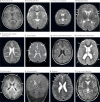International consensus recommendations on the diagnostic work-up for malformations of cortical development
- PMID: 32895508
- PMCID: PMC7790753
- DOI: 10.1038/s41582-020-0395-6
International consensus recommendations on the diagnostic work-up for malformations of cortical development
Abstract
Malformations of cortical development (MCDs) are neurodevelopmental disorders that result from abnormal development of the cerebral cortex in utero. MCDs place a substantial burden on affected individuals, their families and societies worldwide, as these individuals can experience lifelong drug-resistant epilepsy, cerebral palsy, feeding difficulties, intellectual disability and other neurological and behavioural anomalies. The diagnostic pathway for MCDs is complex owing to wide variations in presentation and aetiology, thereby hampering timely and adequate management. In this article, the international MCD network Neuro-MIG provides consensus recommendations to aid both expert and non-expert clinicians in the diagnostic work-up of MCDs with the aim of improving patient management worldwide. We reviewed the literature on clinical presentation, aetiology and diagnostic approaches for the main MCD subtypes and collected data on current practices and recommendations from clinicians and diagnostic laboratories within Neuro-MIG. We reached consensus by 42 professionals from 20 countries, using expert discussions and a Delphi consensus process. We present a diagnostic workflow that can be applied to any individual with MCD and a comprehensive list of MCD-related genes with their associated phenotypes. The workflow is designed to maximize the diagnostic yield and increase the number of patients receiving personalized care and counselling on prognosis and recurrence risk.
Conflict of interest statement
The authors declare no competing interests.
Figures


References
-
- de Wit MC, et al. Cortical brain malformations: effect of clinical, neuroradiological, and modern genetic classification. Arch. Neurol. 2008;65:358–366. - PubMed
Publication types
MeSH terms
LinkOut - more resources
Full Text Sources
Research Materials

